Estación experimental [Experimental Station], an exhibition that just opened at Laboral Centre of Art and Industrial Creation, presents the work of artists who are inspired by scientific research. Whether the relationship they have developed with science is akin to formal research, pataphysics, science-fiction or investigates paranormal events, these artists play with our expectations and question our current knowledge without necessarily looking for a clear answer. What matters in their work is not the end result, but the process, the experiment, the long journey of trial and error.
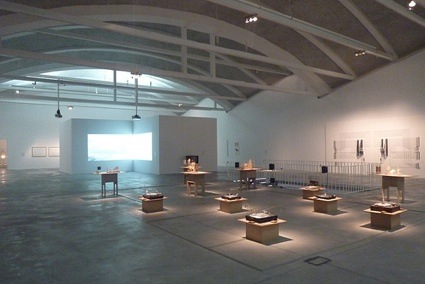 View of the exhibition space
View of the exhibition space
The exhibition is at time playful and amusing and at time leading to more contemplative moments. I was particularly glad that Estación experimental gave me the opportunity to discover so many young Spanish artists. I hope i’ll get to see more of their work in the coming years.
The first chapter of the exhibition gives a general overview of the concept behind the show. In the Laboratory brings together the artists who use their studio or an exhibition space as a place for experimentation. I’ve already mentioned Caleb Charland and the homemade experiments he photographs in his garage.
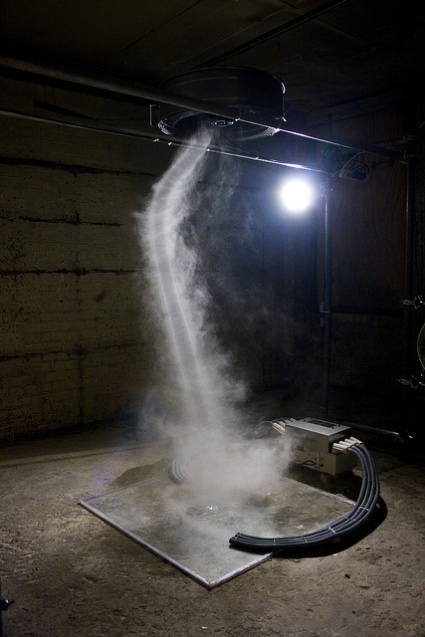 Alistair McClymont, The Limitations of Logic and the Absence of Absolute Certainty, 2010
Alistair McClymont, The Limitations of Logic and the Absence of Absolute Certainty, 2010
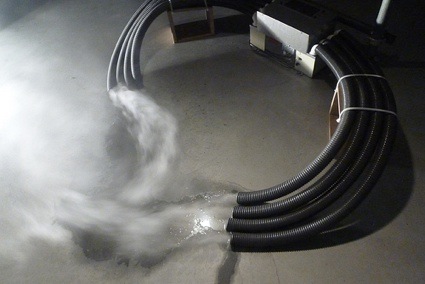 Alistair McClymont, The Limitations of Logic and the Absence of Absolute Certainty (detail), 2010
Alistair McClymont, The Limitations of Logic and the Absence of Absolute Certainty (detail), 2010
Another artist who makes jaw-dropping experiments with physical phenomena is Alistair McClymont who recreated a tornado inside one of the exhibition rooms. The mechanics that activate the rotating column of air are not hidden from visitor’s view: fans, scaffolding, black tubes and a humidifier.
The sculpture uses mundane materials to recreate a rare meteorological phenomenon that can have devastating effects. In the gallery however, visitors are free to step into the whirlwind of air and vapor and experience its physical presence without any danger.
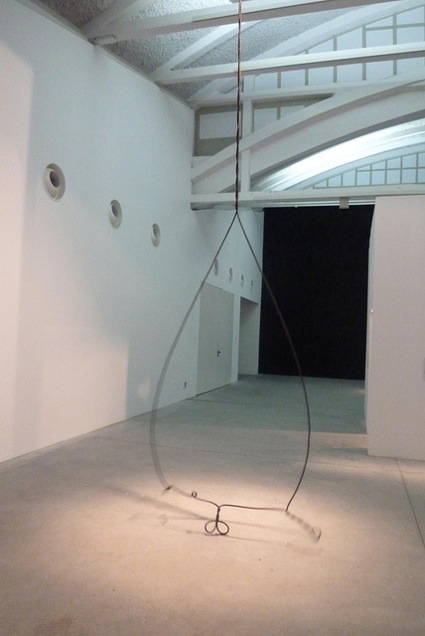 Ben Woodeson, Health & Safety Violation #15 – Spiral twist hazard
Ben Woodeson, Health & Safety Violation #15 – Spiral twist hazard
Danger, or rather the perception of it, is at the core of Ben Woodeson‘s work. The sculpture he’s showing in Laboral bears the tongue-in-cheek name Health & Safety Violation #15 – Spiral twist hazard. I’m all for poking fun at the over-regulations that dominate cultural spaces (especially in England, a country never afraid of reaching new heights of ridicule in that matter.) Spiral Twist Hazard is a black cable that hangs from the ceiling and twists, untwists, whips and moves as if it had a life of its own.
Because the title warns you of the cable ‘purpose’, the threat becomes appealing, it puts visitor to the test: will you dare go nearer or will you retreat safely?
Spiral Twist Hazard is one of the exercises in a long series of “Health and Safety Violations” that the artist began in 2009. I’m quite fond of the aggressive shoe brush (video might take a few moments to load but well worth the wait), the pump that suffocates you by vacuuming air away from the gallery space, the beads thrown on the floor, etc. I like them all. I should interview him one day. Right?
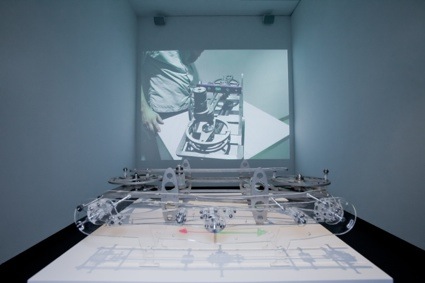 Rubén Ramos Balsa and Oumar Haidara Fall, Fall Machine, 2003-2011
Rubén Ramos Balsa and Oumar Haidara Fall, Fall Machine, 2003-2011
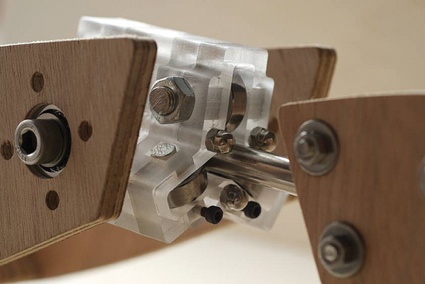 Rubén Ramos Balsa and Oumar Haidara Fall, Fall Machine, 2003-2011 (detail of the autonomous mechanical multiplier)
Rubén Ramos Balsa and Oumar Haidara Fall, Fall Machine, 2003-2011 (detail of the autonomous mechanical multiplier)
Artist Rubén Ramos Balsa worked at the service of engineer Oumar Haidara Fall to help him communicate his physics theory. The video and mock-up on show illustrate in a tangible way the Senegalese scientist’s work on the mechanical disruption of symmetry.
I’m not sure i understood the theory quite clearly but from what i managed to gather, the research questions the laws of gravity inherited from Newton and tests the possibility of increasing mass in the same trajectory.
The project page explains that The work carried out jointly by the engineer and the artist explores and tests the validity of the Autonomous Mechanical Multiplier as a principle that can prove the theory of the evolutionary conservation of the unity of multiple dimensions.
I’ll come back later on this week with more posts about the exhibition but don’t wait for me to check out the catalogue of the show, it’s available as a PDF on Laboral’s website. And here’s a few pitiful photos i made while visiting the show.
Estación experimental [Experimental Station] remains open through April 9, 2012 at Laboral Centre of Art and Industrial Creation in Gijón, Spain.
Previously: Experimental Station – Caleb Charland.
